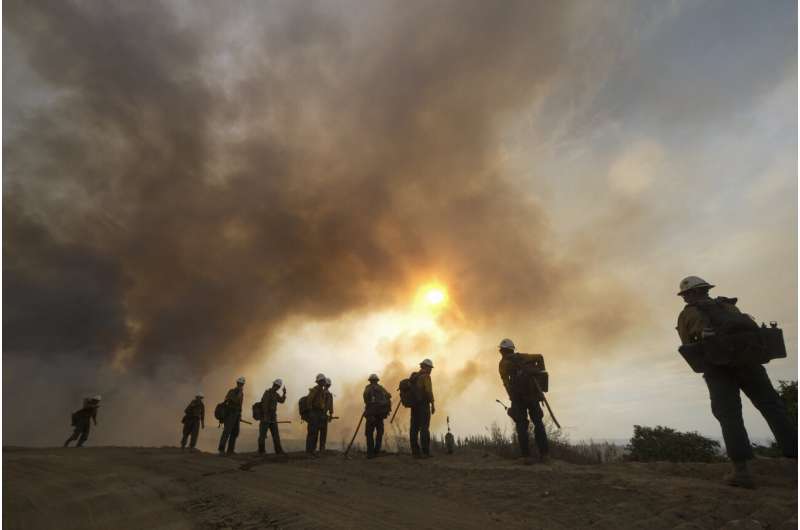Study Finds Low-Income and Nonwhite Communities Most Affected by Extreme Heat and Wildfire Smoke

February 2, 2024
This article has been scrutinized and evaluated according to Science X's editorial protocols and parameters. The editors have taken into consideration the following aspects to ensure the authenticity of the content:
- fact-checked
- peer-reviewed publication
- credible news source
- proofread
by Dorany Pineda
The combination of extreme heat and wildfire smoke has a lethal impact on the human body, specifically giving rise to heightened issues related to respiratory and cardiovascular health. Such an impact is more strongly felt by some communities compared to others.
A recent study published in Science Advances on Friday highlighted how climate change is raising the frequency of these hazards, particularly in California. The authors discovered that this dual threat severely affects hospitalizations, especially impacting marginalized racial communities, low-income societies, and communities with Latino, Black, Asian residents.
The authors, hailing from the Scripps Institution of Oceanography at the University of California, San Diego, and the UCLA Fielding School of Public Health, attribute this to a complex combination of factors including structural racism, discriminatory practices, lack of medical insurance, limited comprehension of health damages and a higher incidence of pre-existing health conditions.
The study also found that other elements such as available resources, infrastructure, and surrounding environment played a role. Areas with readily available cooling centers such as libraries, and homes and workplaces with air conditioning and tree canopy covers are better equipped to deal with extreme heat.
Study author and climate change epidemiologist at UC San Diego, Tarik Benmarhnia, indicated that individuals residing in remote areas with limited social services or amenities faced increased hardships.
The study warns that simultaneous extreme weather conditions such as droughts, heatwaves, and wildfires are poised to become a commonplace occurrence due to climate change.
Moreover, the study points out that similar patterns can be traced in regions of the western United States, Canada, including Oregon, Washington state, British Columbia, and Mediterranean climate regions.
The researchers employed California health records during extreme heat and wildfires episodes. It was found that cardiorespiratory hospitalizations increased by 7% on days with both extreme heat and forest fire smoke.
In the Central Valley and northern mountains of California, a higher frequency of hot weather and wildfires was observed, primarily driven by increased forest fires in nearby mountains.
Benmarhnia noted that Central Valley residents who are more liable to work outdoors and environmental hazards are particularly susceptible to the dangerous health effects of extreme heat and wildfire smoke.
Besides the serious health implications, hospitalization also carries ramifications such as lost hours of work or school, and burdensome medical bills.
During periods of extreme heat, the body struggles to cool itself through perspiration, says Christopher T. Minson, a human physiology professor at the University of Oregon. This can lead to dehydration, which forces the heart to work harder, elevating blood pressure.
Miniscule particles found in wildfire smoke can easily infiltrate the nose and throat, reaching the lungs and, in some cases, the bloodstream, as per the Environmental Protection Agency.
According to Minson, the conjunction of heat and smoke can trigger inflammation in the body, amplifying cardiovascular issues and leading to an escalated risk of heart attacks and other serious health consequences.
A 2022 study by the University of Southern California found that the risk of death surged on days when extreme heat and air pollution coincided. During heat waves, the likelihood of death increased by 6.1%; when air pollution was extreme, it rose by 5%; and on days when both combined, the threat skyrocketed to 21%.
When Dr. Catharina Giudice worked at a hospital in Los Angeles, she noticed an uptick of emergency room visits from patients with various health conditions on extremely hot days. When wildfires blazed, she saw more people with exacerbated asthma and other respiratory diseases.
As climate change fuels the intensity and frequency of heat waves and wildfires, Giudice worries about the low-income and minority communities that are less adapted to them.
'For a variety of reason, they tend to feel climate change much worse than other non-underserved communities, and I think it's really important to highlight this social injustice aspect of climate change,' said the emergency physician and fellow at the Harvard T.H. Chan School of Public Health, who was not part of the study.
The authors noted that agencies like the National Weather Service and local air quality districts issue separate advisories and warnings on days of extreme heat and toxic air. But they argue that 'issuing a joint warning earlier considering the compound exposure would be beneficial.'
Journal information: Science Advances
© 2024 The Associated Press. All rights reserved. This material may not be published, broadcast, rewritten or redistributed without permission.




